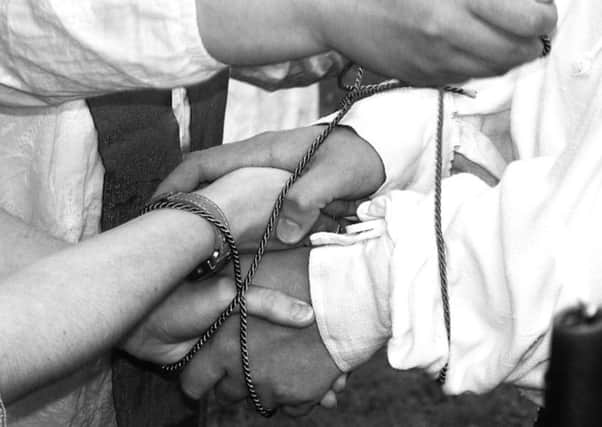The origins of handfasting at Scottish weddings - When Scots ‘married’ for a year and a day


Typically people would become bound in a contract where they would live together for a year and a day - with the couple free to leave each other - and find new spouses - if it didn’t work out.
If the union remained strong, it was often expected couples would go on and marry ‘in full’.
Advertisement
Hide AdAdvertisement
Hide AdHandfasting was outlawed by the Kirk in 1575 but records show that the ceremonies - when couples would have their hands bound together in a symbolic show of togetherness - were still being carried out in churches in Leith 30 years later.
The traditions of handfasting in Scotland are believed to be rooted in the country’s Norse culture, with Danes having the option of “hand-vesten” to illustrate their commitment.
Then, a woman who-lived publicly with man and prepared his meals for three winters became his lawful spouse.
In Scotland, handfasting was used to unite the sons and daughters of clan chiefs.
Then, the birth of a son and heir to the clanship was pivotal to the success of the arrangement.
An article in The Edinburgh Evening News, published in 1896, said: “A son of one chief would marry the daughter of another chief, the bargain being that they lived together for a year and a day.
“If the son was born within the year a the day, the son succeeded all of the rights, but if not son was born within the year and a day, then the contract was dissolved and the parties were at liberty to remarry.
“When a pair married, the elder folks wished them a strange wish. It was ‘happy feet’. Then it was though that happy feet would be a prevention to misfortune of every kind at any kind.”
Advertisement
Hide AdAdvertisement
Hide AdThe article added: “The laws however came from the south and gradually the handfasting marriages were a thing of the past.”
Handfasting marriages were also known as “contracted” marriages with the term appearing in official records.
The arrangement was viewed by some as merely a ‘betrothal’, an article in The Scots Magazine in May 1833 suggests.
The article said: “There can be little doubt, however, that in too many cases, the mere betrothal was looked upon by parties as an actual marriage.
“In 1575 - 15 years after the Reformation - the General Assembly evidently desired to put a stop to this evil.”
The Kirk then decided that those who wished to be married “give in their names that their bands (banns) may be proclaimed.”
Kirk sessions around the country started to react to the change. In Aberdeen, it was ordained “that neither the minister nor reader be present at contractis of their marriage, making as thai call thair handfasting....”
However, according to The Scots Magazine, records of the South Leith Church show that the handfastings were still being “contracted” by the church some 30 years on.
Advertisement
Hide AdAdvertisement
Hide AdHandfasting was also known to have been popular in The Borders where a place called Handfasting Haugh can be found where the White Esk and Black Esk meet near Bailiehill.
Here an annual fair - noted for its handfasting marriages - was held.
A record in the Dumfriesshire Ordnance Survey Name Books from 1848-1858 said: “At that fair it was the custom for persons of both sexes intending to get married to choose a companion according to their liking, with whom they were to live till that time next year.”
If couples decided to stay together following the handfasting, the next step was the proclamation of the banns - with a full wedding under the gaze of the church to follow.
Today, a revival of handfasting has become part of many wedding ceremonies in Scotland when couples hands are bound with cords and ribbons to signify their lasting bond and unity.
While handfasting itself is not legally recognised as constituting a marriage, the ritual is carried out as part of a legal wedding ceremony.
